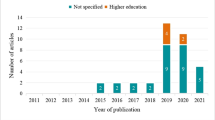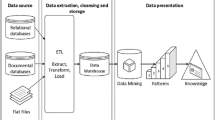Abstract
The purpose of this study was to understand enrollment and performance differences between male and females in higher level secondary STEM courses. This study analyzes performance and enrollment of 355,688 secondary students in higher level STEM courses. This research also enabled an exploration of country level differences. The enrollment research questions are evaluated using chi-square tests, frequency tables, and histograms. Performance research questions are analyzed with hierarchical linear regression and ANOVA with post hocs and Cohen’s d effect size measures. Results suggest that females enroll much less frequently in higher level secondary STEM courses. Females and males perform equally well.






Similar content being viewed by others
Notes
Students may register for individual IB courses and take exams and are referred to as Diploma Course students.
The core content of each SL/HL course overlaps, with more teaching hours dedicated to each component in the HL option, allowing for additional topics and/or more depth. Mathematics HL requires students to complete 5 h of external exams and an internal exploration project. The SL course assesses students on two external exam papers instead of three and also includes short response items and extended response items (IBO, 2012).
Legal status (at level 2) was most significant in the Design Technology model. A reduction in variance of 26.7 % is meaningful, and this indicates that the legal status of a school may play an important role in exam performance. It is worth noting that Design Technology had the smallest sample size, and that a three-level model may not have been the most appropriate method of analysis here due to the uneven distribution of public/private schools in this subject. It is likely that the model is picking up on the proportion of private schools in the sample (Hox, 2010).
References
Bieri-Buschor, C., Berweger, S., Keck-Frei, A. & Kappler, C. (2014). Majoring in STEM—What accounts for women’s career decision making? A mixed methods study. The Journal of Educational Research, 107(3), 167–176. doi:10.1080/00220671.2013.788989.
Bollen, K. A. (1989). Structural equations with latent variables. New York, NY: Wiley.
Brincks, A. (April 14, 2012). Centering decisions in three-level, cross-sectional, contextual models. Annual meeting. Lecture conducted from AERA, Vancouver.
Chinn, S. (2000). A simple method for converting an odds ratio to effect size for use in meta-analysis. Statistics in Medicine, 19(22), 3127–3131.
Cohen, J. (1988). Statistical power analysis for the behavioral sciences (2nd ed.). Hillsdale, NJ: Erlbaum.
Enders, C. K. & Tofighi, D. (2007). Centering predictor variables in a cross-sectional multilevel models: A new look at an old issue. Psychological Methods, 12(2), 121–138.
Greenwood, P. & Nukulin, M. (1996). A guide to chi-squared testing. New York, NY: Wiley.
Griffith, A. L. (2010). Persistence of women and minorities in STEM field majors: Is it the school that matters? Economics of Education Review, 29(6), 911–922. doi:10.1016/j.econedurev.2010.06.010.
Halpern, D., Aronson, J., Reimer, N., Simpkins, S., Star, J., & Wentzel, K. (2007). Encouraging girls in math and science: IES practice guide (NCER 2007–2003). Washington, DC: Institute of Educational Sciences, U.S. Department of Education. Available: http://ies.ed.gov/ncee/wwc/pdf/practiceguides/20072003.pdf
Hill, C., Corbet, C. & Rose, A. (2010). Why so few? Women in science, technology, engineering, and mathematics. Washington, DC: American Association of University Women (AAUW).
Howie, S. & Plomp, T. (2008). Narrowing the gap? Studies in Educational Evaluation, 34(2), 53–130.
Hox, J. (2010). Multilevel analysis: Techniques and applications (2nd ed.). New York, NY: Routledge.
Hyde, J. & Mertz, J. (2009). Gender, culture, and mathematics performance. Proceedings of the National Academy of Sciences, 106, 8,801–8,807.
Ing, M. (2014). Gender differences in the influence of early perceived parental support on student mathematics and science achievement and stem career attainment. International Journal of Science & Mathematics Education, 12(5), 1221–1239.
International Baccalaureate Organization (IBO). (2012). Handbook of procedures for the diploma programme. Geneva, Switzerland: IBO.
Lomax, R. (2007). Multiple comparison procedures. In Statistical concepts: A second course (3rd ed., pp. 27–51). Mahwah, NJ: Erlbaum.
Ma, D. X., Ma, L. & Bradley, K. (2008). Using multilevel modeling to investigate school effects. In A. Connell & D. B. McCoach (Eds.), Multilevel modeling of educational data (pp. 59–110). Charlotte, NC: IAP.
Nagy, G., Garrett, J., Trautwein, U., Cortina, K. S., Baumert, J. & Eccles, J. S. (2008). Gendered high school course selection as a precursor of gendered careers: The mediating role of self-concept and intrinsic value. In H. M. G. Watt & J. S. Eccles (Eds.), Gender and occupational outcomes. Longitudinal assessments of individual, social, and cultural influences (pp. 115–143). Washington, DC: American Psychological Association.
Nagy, G., Trautwein, U., Baumert, J., Koller, O. & Garret, J. (2006). Gender and course selection in upper secondary education: Effects of academic self-concept and intrinsic value. Educational Research and Evaluation, 12, 323–345.
National Science Foundation (NSF) (2006). Science and engineering indicators, (Volume 1). Arlington, VA: National Science Foundation. NSB 06-01.
National Science Foundation (NSF) (2010). Preparing the next generation of STEM innovators: Identifying and developing our nation’s human capital. Arlington, VA: National Science Foundation. NSB 10-33.
Niederle, M. & Vesterlund, L. (2007). Do women shy away from competition? Do men compete too much? Quarterly Journal of Economics, 122(3), 1067–1101.
O’Shea, M., Heilbronner, N. N. & Reis, S. M. (2010). Characteristics of academically talented women who achieve at high levels on the scholastic achievement test-mathematics. Journal of Advanced Academics, 21(2), 234–271.
Raudenbush, S. W. & Bryk, A. S. (2002). Hierarchical linear models applications and data analysis methods (2nd ed.). Thousand Oaks, CA: Sage.
Sarkisian, N. (2013). Hierarchical linear modeling [PDF document]. Retrieved from http://www.sarkisian.net/sc708/learning_HLM6.pdf.
Smith, E. & Gorard, S. (2011). Is there a shortage of scientists? A re-analysis of supply for the UK. British Journal of Educational Studies, 59(2), 159–177.
Snijders, T. & Bosker, R. (2012). An introduction to basic and advanced multilevel modeling (2nd ed.). Thousand Oaks, CA: Sage.
Sun, S., Pan, W. & Wang, L. (2010). A comprehensive review of effect size reporting and interpreting practices in academic journals in education and psychology. Journal of Educational Psychology, 102(4), 989–1004.
Thompson, R. & Bolin, G. (2011). Indicators of success in STEM majors: A cohort study. Journal of College Admission, 212, 18–24.
Tyson, W., Lee, R., Borman, K. M. & Hanson, M. (2007). Science, technology, engineering, and mathematics (STEM) pathways: High school science and math coursework and postsecondary degree attainment. Journal of Education for Students Placed at Risk, 12(3), 243–270.
U.S. Department of Education (2009). Student who study science, technology, engineering and mathematics (STEM) in post secondary education. Washington, DC: U.S. Department of Education.
Author information
Authors and Affiliations
Corresponding author
Electronic supplementary material
Below is the link to the electronic supplementary material.
ESM 1
(PDF 59 kb)
Rights and permissions
About this article
Cite this article
Bergeron, L., Gordon, M. Establishing a STEM Pipeline: Trends in Male and Female Enrollment and Performance in Higher Level Secondary STEM Courses. Int J of Sci and Math Educ 15, 433–450 (2017). https://doi.org/10.1007/s10763-015-9693-7
Received:
Accepted:
Published:
Issue Date:
DOI: https://doi.org/10.1007/s10763-015-9693-7




